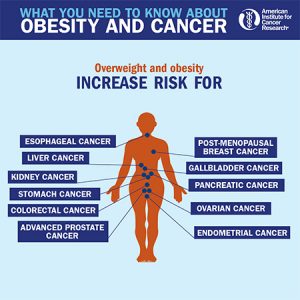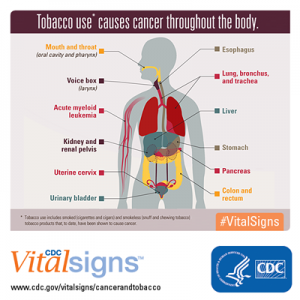It is usually not possible to know exactly why one person develops cancer and another doesn’t. But research has shown that certain risk factors may increase a person’s chances of developing cancer.
The list below includes the most-studied known or suspected risk factors for cancer. Although some of these risk factors can be avoided, others—such as growing older—cannot. Limiting your exposure to avoidable risk factors may lower your risk of developing certain cancers.
Age
Advancing age is the most important risk factor for cancer overall, a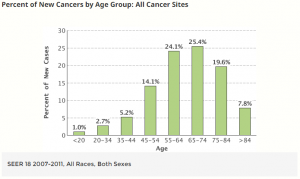 nd for many individual cancer types. According to the most recent statistical data from NCI’s Surveillance, Epidemiology, and End Results program, the median age of a cancer diagnosis is 66 years. This means that half of cancer cases occur in people below this age and half in people above this age. One-quarter of new cancer cases arediagnosed in people aged 65 to 74.
nd for many individual cancer types. According to the most recent statistical data from NCI’s Surveillance, Epidemiology, and End Results program, the median age of a cancer diagnosis is 66 years. This means that half of cancer cases occur in people below this age and half in people above this age. One-quarter of new cancer cases arediagnosed in people aged 65 to 74.
Alcohol
Drinking alcohol can increase your risk of cancer of the mouth, throat, esophagus, larynx (voice box), liver, bowel and breast. The more you drink, the higher your risk. The risk of cancer is much higher for those who drink alcohol and also use tobacco.
Doctors advise people who drink to do so in moderate amounts. The federal government’s Dietary Guidelines for Americans defines moderate alcohol drinking as up to one drink per day for women and up to two drinks per day for men.
Cancer-Causing Substances in the Environment
Cancer is caused by changes to certain genes that alter the way our cells function. Some of these genetic changes occur naturally when DNA is replicated during the process of cell division. But others are the result of environmental exposures that damage DNA. These exposures may include substances, such as the chemicals in tobacco smoke, or radiation, such as ultraviolet rays from the sun.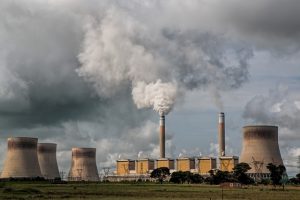
People can avoid some cancer-causing exposures, such as tobacco smoke and the sun’s rays. But others are harder to avoid, especially if they are in the air we breathe, the water we drink, the food we eat, or the materials we use to do our jobs. Scientists are studying which exposures may cause or contribute to the development of cancer. Understanding which exposures are harmful, and where they are found, may help people to avoid them.
Chronic Inflammation
Inflammation is a normal physiological response that causes injured tissue to heal. An inflammatory process starts when chemicals are released by the damaged tissue. In response, white blood cells make substances that cause cells to divide and grow to rebuild tissue to help repair the injury. Once the wound is healed, the inflammatory process ends.
In chronic inflammation, the inflammatory process may begin even if there is no injury, and it does not end when it should. Why the inflammation continues is not always known. Chronic inflammation may be caused by infections that don’t go away, abnormal immune reactions to normal tissues, or conditions such as obesity. Over time, chronic inflammation can cause DNA damage and lead to cancer. For example, people with chronic inflammatory bowel diseases, such as ulcerative colitis and Crohn disease, have an increased risk of colon cancer.
Diet
Many studies have looked at the possibility that specific dietary components or nutrients are associated with increases or decreases in cancer risk.  Studies of cancer cells in the laboratory and of animal models have sometimes provided evidence that isolated compounds may be carcinogenic (or have anticancer activity). Some foods, such as processed and red meat and salt-preserved foods, can increase the risk of developing cancer. While others, such as fruits, vegetables and foods high in fibre, can reduce the risk of cancer.
Studies of cancer cells in the laboratory and of animal models have sometimes provided evidence that isolated compounds may be carcinogenic (or have anticancer activity). Some foods, such as processed and red meat and salt-preserved foods, can increase the risk of developing cancer. While others, such as fruits, vegetables and foods high in fibre, can reduce the risk of cancer.
Hormones
Estrogens, a group of female sex hormones, are known human carcinogens. Although these hormones have essential physiological roles in both females and males, they have also been associated with an increased risk of certain cancers. For instance, taking combined menopausal hormone therapy (estrogen plus progestin, which is a synthetic version of the female hormone progesterone) can increase a woman’s risk of breast cancer. Menopausal hormone therapy with estrogen alone increases the risk of endometrial cancer and is used only in women who have had a hysterectomy.
Immunosuppression
Many people who receive organ transplants take medications to suppress the immune system so the body won’t reject the organ. These “immunosuppressive” drugs make the immune system less able to detect and destroy cancer cells or fight off infections that cause cancer. Infection with HIV also weakens the immune system and increases the risk of certain cancers.
Research has shown that transplant recipients are at increased risk of a large number of different cancers. Some of these cancers can be caused by infectious agents, whereas others are not. The four most common cancers among transplant recipients and that occur more commonly in these individuals than in the general population are non-Hodgkin lymphoma (NHL) and cancers of the lung, kidney, and liver. NHL can be caused by Epstein-Barr virus (EBV) infection, and liver cancer by chronic infection with the hepatitis B (HBV) and hepatitis C (HCV) viruses. Lung and kidney cancers are not generally thought to be associated with infection.
Infectious Agents
Certain infectious agents, including viruses, bacteria, and parasites, can cause cancer or increase the risk that cancer will form. Some viruses can disrupt signaling that normally keeps cell growth and proliferation in check. Also, some infections weaken the immune system, making the body less able to fight off other cancer-causing infections. And some viruses, bacteria, and parasites also cause chronic inflammation, which may lead to cancer.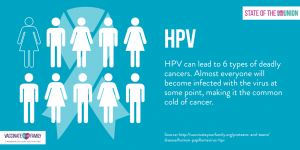
HPV (human papillomavirus) infections are the most common sexually transmitted infections in the United States. About 14 million new genital HPV infections occur each year. In fact, the Centers for Disease Control and Prevention estimates that more than 90% and 80%, respectively, of sexually active men and women will be infected with at least one type of HPV at some point in their lives. Around one-half of these infections are with a high-risk HPV type. Most high-risk HPV infections occur without any symptoms, go away within 1 to 2 years, and do not cause cancer. Some HPV infections, however, can persist for many years. Persistent infections with high-risk HPV types can lead to cell changes that, if untreated, may progress to cancer.
People who are obese may have an increased risk of several types of cancer, including cancers of the breast (in women who have been through menopause), colon, rectum, endometrium (lining of the uterus), esophagus, kidney, pancreas, and gallbladder.
Conversely, eating a healthy diet, being physically active, and keeping a healthy weight may help reduce risk of some cancers. These healthy behaviors are also important to lessen the risk of other illnesses, such as heart disease, type II diabetes, and high blood pressure.
Radiation
Radiation of certain wavelengths, called ionizing radiation, has enough energy to damage DNA and cause cancer. Ionizing radiation includes radon, x-rays, gamma rays, and other forms of high-energy radiation. Lower-energy, non-ionizing forms of radiation, such as visible light and the energy from cell phones and electromagnetic fields, do not damage DNA and have not been found to cause cancer.
Sunlight
The sun, sunlamps, and tanning booths all give off ultraviolet (UV) radiation. Exposure to UV radiation causes early aging of the skin and skin damage that can lead to skin cancer.
People of all ages and skin tones should limit the amount of time they spend in the sun, especially between mid-morning and late afternoon, and avoid other sources of UV radiation, such as tanning beds. It is important to keep in mind that UV radiation is reflected by sand, water, snow, and ice and can go through windshields and windows. Even though skin cancer is more common among people with a light skin tone, people of all skin tones can develop skin cancer, including those with dark skin.
Tobacco use is a leading cause of cancer and of death from cancer. People who use tobacco products or who are regularly around environmental tobacco smoke (also called secondhand smoke) have an increased risk of cancer because tobacco products and secondhand smoke have many chemicals that damage DNA.
Tobacco use causes many types of cancer, including cancer of the lung, larynx (voice box), mouth, esophagus, throat, bladder, kidney, liver, stomach, pancreas, colon and rectum, and cervix, as well as acute myeloid leukemia. People who use smokeless tobacco (snuff or chewing tobacco) have increased risks of cancers of the mouth, esophagus, and pancreas.
There is no safe level of tobacco use. People who use any type of tobacco product are strongly urged to quit. People who quit smoking, regardless of their age, have substantial gains in life expectancy compared with those who continue to smoke. Also, quitting smoking at the time of a cancer diagnosis reduces the risk of death.
Article resource:

